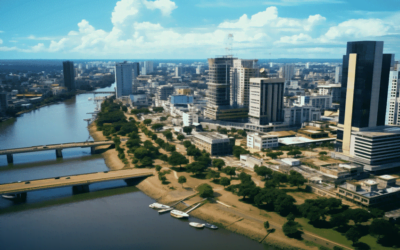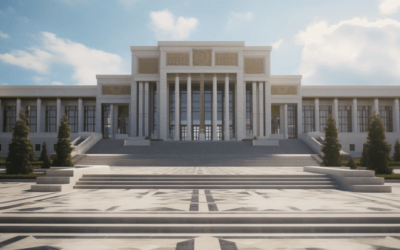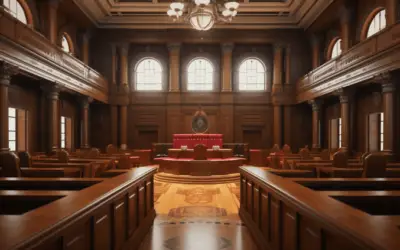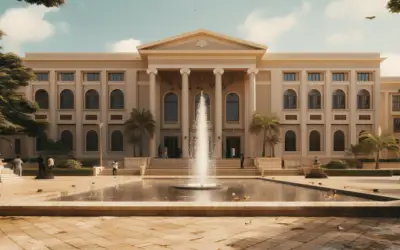Hey there, fellow drone enthusiasts and curious minds! Are you on a quest to unravel the intricate web of Angola’s drone laws? It’s no surprise; I’ve been down that road too, and I get it.
Whether you’re a budding drone pilot, a tech aficionado, or just a concerned citizen, understanding the ins and outs of drone regulations in Angola is essential.
So, let’s embark on this journey together, exploring what’s buzzing in the world of Angola’s drone laws and how they might impact you.
You see, I’ve been on a mission of my own, diving deep into the labyrinth of Angola’s drone regulations. Hours of research, conversations with experts, and sifting through official documents have led me to some fascinating insights.
I’ve uncovered the details you’re searching for, from the basics of registration and flight authorization to the complexities of flying near restricted areas. Rest assured, I’ve got the answers you seek.
Ready to unravel the mysteries of Angola’s drone laws? Look no further. In the following pages, I’ll break down the regulations, provide tips, and share my newfound knowledge so you can navigate the drone skies of Angola with confidence.
So, if you’re on the hunt for the key to understanding and complying with Angola’s drone laws, read on. You won’t be disappointed, and you’ll find all the solutions to your search intent right here. Let’s get started!
- Background on Angola
- Registration and Licensing Drones in Angola
- Flight Authorization in Angola
- Restricted Areas for Drone Operators
- Safety and Privacy Measures in Angola
- Drone Remote Identification in Angola
- Drone Insurance in Angola
- Import and Export Regulations in Angola
- Penalties and Consequences for Offenders
- Final Thoughts on Angola Drone Laws
- Frequently Asked Questions on Drone Laws in Angola
Background on Angola

Hey there, before we delve into the intricate web of Angola’s drone laws, let me paint a vivid picture of this breathtaking African nation. Angola, nestled on the southwest coast of the continent, is a land of astounding natural beauty.
Its diverse landscapes encompass everything from pristine beaches and dense jungles to arid deserts and bustling cities. But beneath this picturesque exterior lies a nation with a growing appetite for technology, especially when it comes to drones.
Angola as the Focus of the Article
Now, when we speak of Angola, it’s essential to know that this nation is not just another dot on the map. Angola has been on a remarkable journey of recovery and development since the end of a brutal civil war in the early 2000s.
And in this transformation, technology, including drones, has played a significant role. The country’s robust potential and rapidly expanding drone industry make it a compelling subject for our exploration.
Angola’s eagerness to embrace emerging technologies and integrate them into its various sectors has been nothing short of impressive. The use of drones in agriculture, environmental monitoring, and even infrastructure development is on the rise.
Imagine drones surveying vast agricultural landscapes, helping farmers optimize their yields, or aiding conservationists in monitoring wildlife populations in Angola’s pristine national parks. The possibilities are boundless, and that’s what makes understanding the drone laws here so crucial.
Potential for Drone Use in Various Sectors in Angola
The potential for drone use extends far beyond these sectors. In Angola, drones are making their mark in disaster response, public safety, and even the film and entertainment industry. They are becoming valuable tools for mapping, surveying, and data collection.
But, and it’s a big ‘but,’ with these exciting prospects comes the need for clear and well-structured drone regulations. It’s about balancing innovation with responsibility, and this balance is what makes Angola’s drone laws an area of keen interest.
Need for Clear Drone Regulations
Drones are more than just gadgets; they are becoming indispensable tools that can drive progress in Angola. But, like any powerful tool, they need to be wielded with care and a deep understanding of the rules that govern their use.
The need for clear drone regulations becomes evident when we consider the safety of the skies, the privacy of citizens, and the orderly development of this emerging industry. Angola recognizes these needs, and that’s where we come in—to explore, understand, and explain the intricacies of Angola’s drone laws. It’s a journey worth taking, my friends, so let’s embark on it together.
Also Read: Andorra Drone Laws 2024
Registration and Licensing Drones in Angola

Now that we’ve laid the groundwork with our introduction, let’s take a closer look at the crucial topic of drone registration and licensing in Angola. Picture this: you’re eager to take your drone to the skies and capture breathtaking aerial views of Angola.
But before you do, there’s a bit of paperwork to attend to.
Requirements for Drone Registration in Angola
In the world of drone flight, registration is the name of the game, and Angola is no exception. Here, drone registration is more than just a formality; it’s a legal requirement.
Just like you need a license to drive a car, your drone needs a registration certificate to take flight in this beautiful country. The primary goal is to create a record of drones operating within Angolan airspace. This serves multiple purposes, including tracking and accountability, safety, and adherence to the law.
How the Registration Process Works
Now, let’s demystify the registration process. It’s a straightforward yet essential step in ensuring your drone complies with Angolan regulations. Typically, you’ll need to provide basic information about yourself and your drone. Think of it like filling out the paperwork when you check into a hotel.
You’ll need to provide your personal details, drone specifications, and the intended use of your unmanned aircraft. Once you’ve got all your documents in order, it’s time to submit them to the National Civil Aviation Institute (INAVIC) or the relevant authorities. And just like that, you’ll be a law-abiding drone operator in Angola.
Need for Licenses or Permits for Drone Operation
Now, what about licenses and permits? These are crucial for specific types of drone operations in Angola. If your drone use goes beyond leisurely flights and ventures into the world of commercial or professional endeavors, you may need additional permits or licenses.
This is all about safety and accountability, ensuring that operators have the necessary skills and knowledge to operate drones in more complex scenarios. It’s somewhat akin to needing a special driver’s license for a commercial truck or bus. These additional permits ensure that operators are well-prepared for their specific roles in the drone ecosystem.
Difference Between Recreational and Commercial Drone Operations
Understanding the difference between recreational and commercial drone operations is fundamental. For recreational flyers, the emphasis is on responsible and safe drone use. But if you plan to use your drone for business or professional purposes, you’ll need to navigate a few extra regulatory hoops.
Differentiating between these two categories can be the key to a smooth and hassle-free drone experience in Angola. Whether you’re flying just for fun or embarking on a professional drone venture, knowing the rules for your specific category is vital. It’s all part of striking that delicate balance between enjoying the skies and respecting the law.
Also Read: Algeria Drone Laws 2024
Flight Authorization in Angola

Now, picture this: your drone is all set, the weather is perfect, and you’re eager to take off into the Angolan skies. But before you hit that throttle, there’s one crucial thing you need: flight authorization. In this segment, we will take a closer look at why it’s so important, how you can get it, and when you might need it.
Importance of Obtaining Flight Authorization
Flight authorization is no mere formality; it’s the cornerstone of responsible and safe drone operation. Think of it as the keys to the kingdom, the green light that says, “You’re good to go!” When you’re up there in the air, you’re not just navigating your drone; you’re sharing the skies with other aircraft, whether they’re manned or unmanned.
Flight authorization ensures that your drone operation doesn’t pose a threat to other aircraft, and it helps authorities keep track of who’s flying, enhancing safety for all.
Process of Applying for Flight Authorization
So, how does one go about obtaining this golden ticket to the skies? It’s a fairly straightforward process. Depending on your specific flight intent, you may need to submit an application detailing your plans. This application typically includes your drone’s details, the location and time of your flight, and the purpose behind it.
This information helps authorities assess the safety and feasibility of your planned operation. Much like obtaining a permit for an event, the flight authorization process aims to ensure everything runs smoothly and without any hiccups.
Examples of Situations Where Flight Authorization May Be Required
Now, when do you need flight authorization? Well, the situations can be diverse. For instance, if you’re planning a commercial drone shoot in the heart of Luanda, Angola’s bustling capital, you’ll likely need authorization.
Similarly, if your drone operation takes you close to sensitive areas like airports, government buildings, or military installations, the authorities want to know about it. The same goes for any drone operation where you’re venturing into a congested urban area or flying at higher altitudes.
The goal is to ensure that your drone operation is not only safe but also respectful of the airspace and privacy of others. So, remember, getting the green light through flight authorization is all about safety, responsibility, and shared airspace harmony.
Also Read: Albania Drone Laws 2024
Restricted Areas for Drone Operators

As drone enthusiasts, we’re always looking to explore the skies and capture breathtaking aerial views. But not all skies are created equal when it comes to drone flights. Let’s talk about restricted areas—those places in Angola where you can’t just take off and fly freely. These areas are more than lines on a map; they’re crucial for safety, privacy, and the well-being of others.
Locations or Zones Where Drone Flights Are Restricted
When we talk about restricted areas, it’s essential to pinpoint where these boundaries lie. You’ll typically find restrictions around airports, military installations, and government buildings in Angola. These locations are sensitive, and understandably so.
They house critical operations and assets that we don’t want to jeopardize. Additionally, drone flights near prisons and other correctional facilities are also restricted to ensure security. Think of these restricted zones as no-fly zones, much like certain areas in a city where you can’t park your car.
Reasons Behind These Restrictions
Now, why are these areas off-limits to drones? The reasons are crystal clear. Around airports, drones can pose a significant risk to manned aircraft during takeoff and landing. Military installations and government buildings house sensitive information, and unauthorized drone flights could compromise security.
Then, there are prisons where drones could potentially be used for illicit activities like smuggling. So, the restrictions are not about spoiling the fun; they’re about ensuring the safety, security, and integrity of these critical areas.
Consequences of Flying Drones in Prohibited Areas
We all love the thrill of flying our drones, but it’s important to respect the rules, especially when it comes to restricted areas. Flying your drone where it’s not allowed can lead to some severe consequences. Authorities take these restrictions seriously.
If you’re caught flying your drone in a no-fly zone, you could face penalties, including fines, confiscation of your drone, and potentially even legal consequences.
It’s not just about the risk to your drone; it’s about the risk to others and the consequences that follow. So, always make sure you know where you can and can’t fly your drone to ensure a safe and enjoyable experience for everyone.
Also Read: Afghanistan Drone Laws 2024
Safety and Privacy Measures in Angola

Safety and privacy are like the twin pillars of responsible drone operation.
As we explore the fascinating world of Angola’s drone laws, it’s crucial to shine a spotlight on these two crucial aspects. Let’s delve into why they matter and how you can ensure your drone flights are not only exhilarating but also safe and respectful.
Importance of Safety Guidelines for Drone Operators
Imagine a drone flying high above, capturing stunning images or surveying vast landscapes. It’s a thrilling experience, but it comes with a significant responsibility: ensuring the safety of people, property, and other aircraft.
That’s where safety guidelines come into play. Whether you’re a seasoned pro or just starting your drone journey, following safety guidelines is not optional.
It’s about avoiding accidents, preventing damage, and maintaining the reputation of the drone community. Think of it as the traffic rules of the sky; they’re there to keep everyone safe.
Privacy Concerns Related to Drone Use
Privacy is another critical facet of drone operations. While drones offer fantastic aerial perspectives, they also raise concerns about invading personal space and privacy. Picture this scenario: you’re sunbathing in your backyard, and suddenly, a drone buzzes overhead, snapping pictures without your consent.
That’s where privacy concerns come into play. Drone operators must respect the privacy of individuals, avoiding intrusive flights near private properties or sensitive areas.
Just like we wouldn’t want someone peeking into our homes, respecting the privacy of others is a fundamental principle of responsible drone operation.
Operators Can Ensure Safe and Responsible Drone Flight
So, how can we balance the thrill of drone flight with safety and privacy? It all boils down to responsible and mindful operation.
Operators should familiarize themselves with safety guidelines, which often cover aspects like maintaining a safe distance from people and property, respecting no-fly zones, and flying within their line of sight. When it comes to privacy, it’s all about being considerate.
Avoid flying over private property without permission, and be cautious when capturing images or videos in public spaces to avoid infringing on people’s privacy. Responsible drone operation is not just about rules; it’s about being a conscientious pilot who contributes to safe and enjoyable skies for all.
Drone Remote Identification in Angola

Now, let’s talk about a game-changer in the world of drone regulations: remote identification. It’s like giving your drone an ID card, and it’s an important topic in the context of Angola’s drone laws. So, let’s dive into what it is, why it matters, and how it all works.
Requirements for Remote Identification Systems
Remote identification is not just a fancy tech term; it’s a requirement for all drones in Angola. Think of it as a digital license plate for your drone.
The rule mandates that all drones, whether used for recreation or business, need to be equipped with a remote identification system. This system allows authorities to identify and track drones in real-time. It’s all about enhancing accountability and safety in the skies.
Purpose and Benefits of Remote Identification
But why the buzz around remote identification? The primary purpose is to ensure that the skies are safe and secure. With remote identification, authorities can quickly identify the owner and operator of any drone in the air. This is especially critical in scenarios like law enforcement, where identifying rogue drones swiftly is essential.
Additionally, remote identification helps in scenarios like search and rescue missions, ensuring that authorized drones can be swiftly deployed. The benefits are numerous: increased accountability, safer skies, and the ability to harness the full potential of drone technology.
Technical Aspects of Complying with This Requirement
Complying with the remote identification requirement involves equipping your drone with a system that broadcasts important information during flight. This includes data like your drone’s identification number, your location, and the drone’s altitude.
It’s much like the transponder in an aircraft, which broadcasts crucial information to air traffic control. While it may sound complex, the technology has advanced to make compliance straightforward.
Drones are becoming smarter, and remote identification is a pivotal step in ensuring that the skies remain accessible, safe, and secure for all operators.
Drone Insurance in Angola

Let’s talk about something that might not be as thrilling as flying your drone, but it’s just as essential – insurance. In the world of drone operation, having the right coverage can make all the difference. So, let’s delve into why drone insurance is a necessity, what it covers, and how you can ensure you’re adequately protected.
Necessity of Liability Insurance for Drone Operators
Whether you’re a recreational drone enthusiast or a professional pilot, liability insurance is a must. Think of it as a safety net that protects you and others from unexpected mishaps. Accidents happen, and drones are no exception.
Imagine your drone accidentally colliding with someone’s property or causing injury. Without insurance, you could find yourself in a tricky situation, facing financial liability for damages or injuries. Liability insurance is your shield against these unexpected and potentially costly events.
Explain the Coverage and Protection Provided by Drone Insurance
Now, what exactly does drone insurance cover? It typically includes liability coverage, which protects you in the event your drone causes property damage or bodily injury to someone else. This is essential, not just for your peace of mind, but for the well-being of others who might be affected by your drone’s operations.
Additionally, some insurance plans offer coverage for equipment damage, theft, or loss. It’s like having a safety net for your valuable drone and gear. The bottom line is that drone insurance is about safeguarding your financial well-being and ensuring that you can continue enjoying your passion without undue worries.
Provide Information on How Operators Can Obtain the Required Insurance
Getting the right insurance for your drone is relatively straightforward. There are insurance providers that specialize in drone coverage, and you can explore different plans based on your needs. It’s somewhat akin to selecting an insurance plan for your car or home.
You choose the coverage that suits your situation, pay the premium, and you’re good to go. It’s a responsible move that every drone operator should consider to ensure smooth and enjoyable flights without the burden of unexpected financial setbacks.
So, whether you’re a weekend flyer or a professional pilot, drone insurance is a safety net that’s well worth the investment.
Import and Export Regulations in Angola

Let’s explore the world of importing and exporting drones in the context of Angola’s drone laws. You might wonder, “What’s there to know about bringing drones in and out of the country?” Well, more than you might think. There are regulations to consider, and getting a grasp of them can make your drone journey smoother. So, let’s uncover the specifics.
Specific Regulations Related to Importing or Exporting Drones in Angola
When it comes to importing or exporting drones in Angola, you’ll want to be aware of any specific regulations in place. While Angola typically follows international guidelines for trade and customs, there may be additional requirements when it comes to drones.
It’s somewhat akin to knowing what you can and can’t bring when traveling to a foreign country. Having a clear understanding of the regulations is vital to ensure that you don’t encounter any hiccups in the import or export process.
Procedures and Restrictions for Bringing Drones into the Country
The procedures for bringing drones into the country are often linked to customs and import regulations. You may need to declare your drone, provide documentation, or pay import duties or taxes, depending on the value and purpose of your drone.
It’s a bit like going through customs at an airport, where you declare any items you’re bringing into the country. Additionally, there might be restrictions on the types of drones or the quantities you can import or export.
Understanding these procedures can help you avoid unexpected delays or complications when dealing with customs and border authorities.
In essence, the key takeaway is that just like traveling, importing or exporting drones involves adhering to regulations and following the procedures laid out by the authorities.
Knowing what’s expected can save you time and ensure that your drone-related activities, whether they involve bringing drones into the country or taking them abroad, are hassle-free and compliant with Angola’s rules and regulations.
Penalties and Consequences for Offenders

Now, let’s talk about something a tad less exciting but profoundly important – the penalties and consequences of not playing by the rules when it comes to drone regulations. Think of it as the ‘what happens if you don’t’ part of the story. It’s the legal fine print that every drone operator needs to be aware of.
Potential Penalties for Violating Drone Regulations
Drone regulations in Angola are not just for show; they come with a set of penalties that can be quite hefty. If you’re caught flying your drone in a no-fly zone, invading someone’s privacy, or breaching any other regulation, you could face fines.
These fines can vary based on the severity of the violation and can range from a slap on the wrist to a substantial financial setback. Think of it like getting a traffic ticket for speeding; the penalties can add up if you’re not careful.
Legal Consequences of Non-Compliance
Beyond fines, non-compliance with drone regulations can have more severe legal consequences. It can lead to legal action, which may involve court proceedings. This can not only be a time-consuming process but can also result in more significant financial and legal ramifications.
Just as violating other laws can lead to arrests and court appearances, disregarding drone regulations can put you on the wrong side of the law. So, it’s not just about losing a bit of cash; it’s about ensuring you don’t find yourself in a legal quagmire.
Importance of Adhering to Regulations to Avoid Legal Issues
The bottom line is this: adhering to drone regulations isn’t just about following rules; it’s about avoiding legal issues that can be both financially and emotionally taxing.
Whether you’re flying for fun or for a professional endeavor, understanding and obeying the rules is not just the right thing to do; it’s the smart thing to do.
t ensures you can enjoy your drone flights without looking over your shoulder and, most importantly, keeps the skies safe and harmonious for everyone. So, always fly safe, fly smart, and fly by the rules.
Final Thoughts on Angola Drone Laws

We’ve embarked on quite the journey through the skies, exploring the ins and outs of Angola’s drone laws. Now, as we wrap up this adventure, let’s take a moment to reflect on what we’ve learned and why it all matters. It’s like landing your drone safely after an exhilarating flight – a moment of reflection and pause.
Throughout our exploration, we’ve uncovered the essentials of Angola’s drone laws. From registration and licensing to flight authorization, restricted areas, safety, and privacy, we’ve traversed the regulatory landscape that governs our drone journeys.
We’ve also delved into the crucial aspects of insurance, remote identification, and the potential penalties and consequences of non-compliance. It’s been a comprehensive journey, filled with insights and knowledge.
Understanding and adhering to Angola’s drone laws is not just a legal obligation; it’s a responsibility to yourself, others, and the skies we share. By following these regulations, we contribute to a safer, more responsible drone community.
Just as traffic rules keep the streets orderly and safe, drone laws ensure that our skies remain accessible and secure. It’s about striking a balance between the freedom to explore the skies and the obligation to do so safely and responsibly.
As we conclude, let’s encourage one another to be responsible and safe drone operators.
Whether you’re a hobbyist capturing the beauty of Angola’s landscapes or a professional using drones for various applications, let’s keep in mind that responsible drone operation is not just a legal requirement; it’s a shared commitment to safety, privacy, and accountability.
By adhering to the regulations and promoting safe practices, we can enjoy the thrill of drone flight while ensuring that the skies remain a source of wonder and inspiration for generations to come. So, here’s to many more safe and responsible drone adventures in Angola and beyond!
Frequently Asked Questions on Drone Laws in Angola
1. Are drone regulations in Angola strict, and what are the key aspects to be aware of?
Yes, drone regulations in Angola are in place to ensure safety and accountability in the airspace. Key aspects include the requirement for registration and licensing, flight authorization for certain operations, compliance with remote identification systems, and respect for no-fly zones. Understanding these regulations is vital for safe and legal drone operations.
2. What are the penalties for violating drone regulations in Angola?
Penalties for violating drone regulations in Angola can range from fines to legal consequences. Depending on the severity of the violation, fines may be imposed. Non-compliance can also lead to legal action, including court proceedings. It’s essential to adhere to the rules to avoid financial and legal setbacks.
3. Is drone insurance mandatory in Angola, and what does it cover?
Drone insurance is not mandatory in Angola but is highly recommended. It provides coverage for liability, protecting you from financial liability in case of property damage or bodily injury caused by your drone. Some insurance plans may also cover equipment damage, theft, or loss, depending on the policy.
4. What are the restricted areas for drone flights in Angola, and why are they restricted?
Restricted areas in Angola include airports, military installations, government buildings, and correctional facilities. These areas are restricted to ensure safety, security, and the protection of sensitive information. Drones flying near these locations could pose a threat to manned aircraft, compromise security, or be used for illicit activities.
5. How can I ensure safe and responsible drone operations in Angola?
To ensure safe and responsible drone operations in Angola, it’s crucial to familiarize yourself with the regulations and safety guidelines. Always respect no-fly zones, privacy, and airspace rules. Additionally, consider obtaining liability insurance to protect yourself from unexpected incidents. Adhering to these rules and promoting safe practices is essential for responsible drone operations in Angola.













